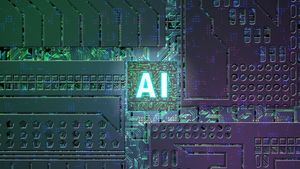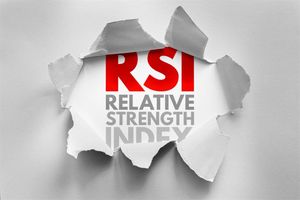
The Artificial Intelligence (AI) sector has been a dramatic theater for investors in 2025, experiencing a significant period of volatility that saw the much-hyped "AI trade" lose considerable steam, only to stage a powerful and surprising rebound. This rollercoaster ride has left market participants grappling with mixed sentiments, balancing the undeniable transformative potential of AI against persistent concerns of overvaluation and the sustainability of its rapid expansion. As of late September 2025, the market is attempting to discern whether the recent resurgence signifies a stable new growth phase or merely a temporary reprieve in an inherently frothy environment.
The immediate implications of these sharp movements are profound. Investor sentiment has become increasingly nuanced, shifting from outright speculative enthusiasm to a more discerning focus on fundamental strength and tangible returns. While the long-term growth trajectory for AI remains robust, the recent swings underscore the sector's sensitivity to macroeconomic shifts, competitive pressures, and regulatory uncertainties. This period of intense fluctuation is forcing a re-evaluation of investment strategies and highlighting the critical importance of distinguishing between genuine innovation and speculative hype within the burgeoning AI landscape.
The AI Trade's Wild Ride: From Euphoria to Correction and Back
The "AI trade" initially gained significant momentum in 2023 and 2024, propelling the S&P 500 to impressive gains, reminiscent of the early stages of the dot-com boom. Semiconductor stocks, often dubbed "AI Builder" companies due to their foundational role in AI infrastructure, led this charge, soaring approximately 130% from early 2023 to mid-2024. However, this period of euphoria came to an abrupt halt in early January 2025, initiating a steep collapse in AI technology stocks.
A significant catalyst for this downturn was the emergence of DeepSeek, a Chinese AI model, which demonstrated comparable performance to leading Western contenders but at a fraction of the cost. This development immediately raised questions about the necessity and cost-effectiveness of the expensive AI infrastructure previously deemed essential, rattling investor confidence. The market experienced a sharp correction, with the Nasdaq 100 plummeting 13% from its February peak by March 2025. The "Magnificent 7" tech stocks collectively shed an astounding $2.7 trillion in market capitalization since January, and Nvidia (NASDAQ: NVDA), a bellwether for the AI chip industry, suffered a 16% single-day plunge in late January. By April 2025, the S&P 500 had tumbled as much as 19% from its high, officially entering correction territory, partly exacerbated by aggressive tariff announcements and trade policy uncertainty.
The sentiment continued to sour through the summer, with "AI Applier" stocks—software companies leveraging AI—beginning to lose steam. By August 2025, companies like Salesforce (NYSE: CRM), Adobe (NASDAQ: ADBE), and ServiceNow (NYSE: NOW) were down at least 16% for the year, wiping out an estimated $160 billion in combined market value. Investor skepticism peaked in late September 2025, fueled by concerns over Nvidia's reported $100 billion partnership with OpenAI and a sharp downgrade for Oracle (NYSE: ORCL), which saw its stock fall over 10% after a sell rating predicted a potential 40% downside.
Yet, just as despair seemed to set in, the second quarter of 2025 marked a robust recovery. By July, a basket of 38 AI stocks tracked by Morningstar had surged by 27.3% in Q2 alone, pushing year-to-date gains to a respectable 15%. This powerful comeback was largely fueled by confirmed reports of sustained, robust demand for AI services and and ongoing data center buildouts, demonstrating that underlying demand for AI infrastructure remained strong despite valuation concerns. Leading this resurgence were stocks like Broadcom (NASDAQ: AVGO), with a 65.0% return, and Palantir Technologies (NYSE: PLTR), which rose 61.5% in the second quarter. The S&P 500 surpassed 6,500 points in Q3 2025, largely attributed to the strong performance of tech giants heavily invested in AI. Positive inflation data and strong company news, such as Alibaba Group Holding Limited's (NYSE: BABA) AI investment announcements and robust quarterly earnings from Micron Technology (NASDAQ: MU), further bolstered market relief in late September 2025, signaling a potential stabilization and renewed optimism in the sector.
Corporate Fortunes in the AI Crucible
The recent volatility has created a clear delineation between potential winners and losers in the AI sector, forcing companies to adapt or risk being left behind. Nvidia (NASDAQ: NVDA), despite its momentary single-day plunge in January, remains a pivotal player. Its dominance in AI chips, particularly GPUs essential for training and running large language models, positions it as a primary "AI Builder." The rebound in demand for AI services and data center buildouts directly benefits Nvidia, as its hardware is the backbone of this expansion. However, concerns about its valuation and the sustainability of partnerships, such as the reported one with OpenAI, highlight the fragility of even market leaders to shifts in investor sentiment and competitive dynamics.
"AI Applier" companies like Microsoft (NASDAQ: MSFT), Alphabet (NASDAQ: GOOGL), and Amazon.com (NASDAQ: AMZN) are strategically positioned to be long-term winners. These tech giants are not only developing their own foundational AI models but are also integrating AI across their vast product ecosystems, from cloud services (Azure, Google Cloud, AWS) to enterprise software and consumer applications. Their massive R&D budgets, extensive customer bases, and ability to monetize AI services across multiple verticals provide a significant competitive advantage. The recent "phase-shift" observed since mid-July 2024, where AI Applier stocks began outperforming AI Builder stocks, suggests that investors are increasingly valuing the practical application and monetization of AI over just the foundational hardware.
Conversely, some companies have faced significant headwinds. Software companies like Salesforce (NYSE: CRM), Adobe (NASDAQ: ADBE), and ServiceNow (NYSE: NOW) experienced a notable downturn in mid-2025 as investors questioned the immediate monetization potential of their AI integrations and shifted focus. While these companies are actively embedding AI into their platforms, the market initially punished them for perceived slower growth or higher investment costs relative to their AI builder counterparts. Oracle (NYSE: ORCL) also faced a sharp downgrade, highlighting how even established tech players with significant cloud infrastructure can be vulnerable to market skepticism regarding their AI strategy and valuation. Smaller AI startups, particularly those without strong balance sheets or clear paths to profitability, are also at increased risk during periods of heightened volatility, as investor capital tends to flow towards more established and secure players.
Wider Significance: Beyond the Stock Tickers
The recent AI stock volatility is not an isolated event but rather a critical episode within broader industry trends, signaling a maturing, albeit still nascent, market. This period of correction and rebound underscores the industry's transition from pure speculative hype to a more discerning phase where tangible use cases, profitability, and sustainable business models are increasingly scrutinized. The emergence of cost-effective alternatives like DeepSeek points to an intensifying competitive landscape, suggesting that the "AI arms race" will increasingly favor efficiency and broader accessibility, potentially democratizing AI capabilities and challenging the dominance of incumbent, high-cost solutions.
The ripple effects of this volatility extend across the tech ecosystem. Competitors are forced to innovate faster, differentiate their offerings, and demonstrate clear ROI for their AI investments. Partners, particularly those in the data center and cloud infrastructure sectors, remain crucial, but their fortunes are intrinsically tied to the sustained demand for AI processing power. The shifting investor focus from "AI Builders" to "AI Appliers" also suggests a market belief that the core infrastructure is largely in place, and the next wave of value creation will come from how AI is integrated and monetized in everyday applications and enterprise solutions.
Regulatory and policy implications are also coming to the forefront. Intensifying scrutiny, including antitrust reviews and policy uncertainty, particularly under the prospect of changing administrations, raises the risk of abrupt market shifts for AI companies. Governments worldwide are grappling with how to regulate AI to ensure ethical use, data privacy, and fair competition without stifling innovation. This regulatory overhead adds another layer of complexity and potential risk to an already volatile sector. Historically, comparisons to the dot-com bubble of 2000 are frequently drawn, with analysts cautioning against sky-high multiples for leading AI names. While AI's transformative potential is undeniable, the market is wary of repeating past mistakes, advocating for a more fundamentals-driven approach to valuation.
What Comes Next: Navigating the Future of AI
Looking ahead, the AI sector faces both significant opportunities and formidable challenges. In the short term, the market will likely continue to exhibit sensitivity to macroeconomic data, corporate earnings reports, and any new developments in AI model capabilities or competitive offerings. Investors will be closely watching for sustained demand for AI services, particularly in cloud computing and enterprise applications, as well as clear evidence of profitability from AI investments. The "phase-shift" towards "AI Appliers" suggests a short-term focus on companies that can effectively integrate and monetize AI within their existing product suites, offering clear value propositions.
In the long term, the trajectory for AI remains one of explosive growth, with the global AI market projected to reach over USD 2.4 trillion by 2032. This growth will be fueled by relentless innovation, substantial capital injections, and the accelerating integration of AI across diverse industries, including healthcare, transportation, and manufacturing. Strategic pivots or adaptations will be crucial for companies to thrive. This includes investing in proprietary AI models, securing access to vast datasets, developing specialized AI talent, and forming strategic partnerships to enhance capabilities and market reach. For hardware providers, the focus will shift towards more energy-efficient and specialized AI chips, while software companies will prioritize user-friendly, scalable AI solutions.
Potential market opportunities will emerge in niche AI applications, ethical AI development, and AI-powered cybersecurity solutions. However, challenges persist, including the ongoing talent shortage, the high cost of AI development and deployment, and the evolving regulatory landscape. Potential scenarios include a continued, albeit more measured, growth trajectory for the sector, possibly punctuated by smaller corrections as the market digests new information and adjusts valuations. A more pessimistic scenario could see a larger "AI bubble" burst if valuations become too detached from fundamentals, leading to a more significant market downturn. Conversely, a highly optimistic scenario envisions AI driving unprecedented productivity gains and economic expansion, leading to sustained, robust growth across the sector. Investors should monitor key indicators such as enterprise AI adoption rates, the development of open-source AI models, and the impact of AI on corporate profit margins.
Wrapping Up: A Resilient Yet Wary Market
The recent volatility and subsequent rebound in AI stocks underscore a fundamental truth about this transformative technology: its immense potential is matched only by the inherent complexities and uncertainties of its market integration. Key takeaways from this period include the market's increasing discernment, shifting focus from pure speculative growth to tangible applications and profitability, and the critical role of both "AI Builder" and "AI Applier" companies in shaping the future. While the initial euphoria may have cooled, the underlying demand for AI solutions remains robust, driven by ongoing data center buildouts and the accelerating integration of AI across industries.
Moving forward, the AI market is likely to be characterized by continued innovation, intense competition, and a heightened awareness of valuation. The "AI bubble" concerns will persist, serving as a healthy reminder for investors to conduct thorough due diligence and prioritize companies with strong fundamentals, clear competitive advantages, and sustainable business models. The market will reward those who can effectively navigate the evolving technological landscape, adapt to regulatory pressures, and demonstrate a clear path to monetizing their AI investments.
Investors in the coming months should closely watch for several critical factors: the pace of enterprise AI adoption, particularly in non-tech sectors; the profitability and cash flow generation of leading AI companies; any significant breakthroughs in AI model efficiency or cost reduction; and the evolving global regulatory framework for AI. The AI revolution is far from over, but its next phase demands a more mature and strategic approach from all market participants.
This content is intended for informational purposes only and is not financial advice






